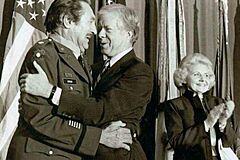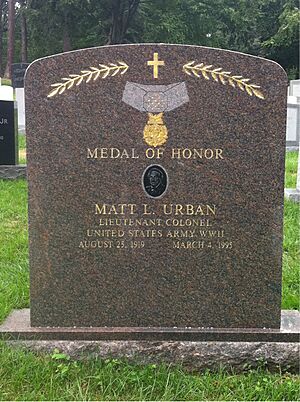Matt Urban facts for kids
Quick facts for kids
Matt Urban
|
|
|---|---|

Urban wearing his Army uniform after receiving the Medal of Honor in 1980
|
|
| Birth name | Matt Louis Urbanowicz |
| Nickname(s) | "Matty" "The Ghost" |
| Born | August 25, 1919 Buffalo, New York, U.S. |
| Died | March 4, 1995 (aged 75) Holland, Michigan, U.S. |
| Buried | |
| Allegiance | United States |
| Service/ |
United States Army |
| Years of service | 1941–1946 |
| Rank | Lieutenant colonel |
| Commands held | 2nd Battalion, 60th Infantry, 9th Infantry Division |
| Battles/wars | World War II |
| Awards | Medal of Honor Silver Star (2) Legion of Merit Bronze Star Medal w/ "V" Device (3) Purple Heart (7) |
Matt Louis Urban (born August 25, 1919 – died March 4, 1995) was a brave United States Army officer. He became a lieutenant colonel and was one of the most honored American soldiers in World War II. Matt Urban showed amazing courage in battles, even though he was hurt many times. He earned more than a dozen awards for his bravery, including seven Purple Hearts. In 1980, he received the highest military award, the Medal of Honor, for his actions in France and Belgium in 1944.
Contents
Early Life and Education
Matt Urban was born Matthew Louis Urbanowicz in Buffalo, New York. His father, Stanley, was an immigrant from Poland. His mother, Helen, was born in Depew, New York.
Matt went to East High School in Buffalo and finished in 1937. He had three brothers.
In 1937, Urban started college at Cornell University in Ithaca, New York. He studied history and government. He also joined the Reserve Officers Training Corps (ROTC). He was part of the track and boxing teams too. He graduated in 1941.
Military Career in World War II
Matt Urban joined the U.S. Army on July 2, 1941. He became a second lieutenant of infantry. His first job was leading a group of soldiers in the 60th Infantry Regiment. This regiment was part of the 9th Infantry Division.
Urban fought in six major campaigns during World War II. He was hurt seven times in battle. He was promoted several times, becoming a major and then a lieutenant colonel. He left the Army in 1946 due to his injuries.
Fighting in North Africa
Urban first saw combat on November 8, 1942. This was the first day of the invasion of North Africa. He landed on the beach under enemy fire. He earned a Silver Star and a Purple Heart there.
While fighting in Tunisia, he was wounded by grenade shrapnel. But he refused to leave. He even captured a German soldier and used his weapon against the enemy.
Battles in Sicily
In July 1943, Urban's unit arrived in Palermo, Sicily. German planes attacked their ship. Urban bravely helped an anti-aircraft gun crew shoot down a German plane.
Later, his unit was given a tough mission. They had to cross mountains in central Sicily without being seen. This helped them surprise the Germans. This smart move saved many American lives. Sicily was freed on August 20. Urban received another Silver Star for his actions in Sicily.
Courage in France
Urban and his battalion landed on Utah Beach in France on June 11, 1944. On June 14, his company faced heavy German fire. Urban grabbed a bazooka and destroyed two German tanks. This helped his company move forward.
Later that day, he was hit in the leg by shrapnel. Even though he was hurt, he refused to leave. He kept directing his soldiers while being carried on a stretcher.
The next day, he was wounded again in his arm. He was sent to a hospital in England. But when he heard his unit was losing many experienced officers, he left the hospital. He trained new soldiers and then hitchhiked back to his unit in France.
On July 25, Urban found his unit stuck in a fight. German machine guns had them pinned down. He helped a wounded tank driver escape a burning tank. Then, he bravely climbed onto another tank. He used its machine gun to attack the German positions. His actions inspired his battalion to push forward.
His commander, Major Max L. Wolf, saw everything. He recommended Urban for the Medal of Honor. Urban was then made the executive officer of the battalion.
On August 2, Urban was wounded in the chest. The shrapnel just missed his heart. Again, he refused to go to a hospital. On August 6, his commander, Major Wolf, was killed. Urban, only 24 years old, took command of the battalion. He was wounded again on August 15 but stayed with his unit.
Fighting in Belgium
On September 3, 1944, Urban's battalion attacked a Belgian town called Philippeville. Urban scouted the town and found many German soldiers there. During the attack, he charged a German machine gun position. He was shot through the neck.
His men quickly helped him. They bandaged his wounds and dragged him to safety. A doctor performed a surgery on him right there. The chaplain even gave him last rites, thinking he would not survive. But Urban did survive. He was sent to a hospital in England. On October 2, 1944, he was promoted to major.
Return to Germany
In December, Urban got a pass to Scotland. But he went back to his battalion in Germany instead. His men were surprised to see him, as they thought he had died. Even though he couldn't speak well, he asked for a combat assignment. His request was denied because of his injuries. He stayed with his unit for a short time before returning to England.
Life After the War
After the war, Matt Urban worked as a writer and editor. In 1946, he officially changed his name to Matt Urban.
In 1949, he became the Recreation Director in Port Huron, Michigan. Later, he worked as the Director of the Monroe Community Center. He coached basketball, baseball, and football. He even helped train young boxers, including Muhammad Ali.
From 1972 to 1989, he directed the Recreation Department for Holland, Michigan. He started a camp for children who needed help. He was also involved with the Red Cross and Boy Scouts. He was inducted into the Softball Hall of Fame.
In 1989, Urban retired and wrote a book about his life. It was called The Matt Urban Story.
Receiving the Medal of Honor
In 1979, a friend helped look into why Matt Urban had not received the Medal of Honor. They found that his commander, Major Max L. Wolf, had recommended him for the medal in 1944. But the paperwork had been lost.
In 1980, the U.S. Army completed the process. On July 19, President Jimmy Carter presented Matt Urban with the Medal of Honor. This was the highest military award. Many of his old army friends were there to see it. Before this, he also received other awards, including the Legion of Merit and his seventh Purple Heart. He also received a French award called the Croix de Guerre.
Death and Burial
Matt Urban passed away on March 4, 1995, in Holland, Michigan. He was 75 years old. His death was caused by a collapsed lung, which was linked to his war injuries. He is buried at Arlington National Cemetery in Arlington, Virginia.
Awards and Honors
Matt Urban received many military awards for his bravery. These include:
- Medal of Honor
- Two Silver Stars
- Legion of Merit
- Three Bronze Star Medals (two for heroism)
- Seven Purple Hearts
He also received many personal honors, such as:
- Man of the Year Award (1953), Monroe, Michigan
- Matt Urban Day (1979), Holland, Michigan
- Induction into the National Softball Hall of Fame (1980)
- The Matt Urban Sports Complex (1996) in Holland, Michigan, was named after him.
- The Matt Urban Center (2000) in Buffalo, New York, helps people in the community.
- A bridge in Monroe County, Michigan, was named the Matt Urban Memorial Bridge in 2014.
- A building at Fort Jackson, South Carolina, was named "Urban Hall" in 2017.
See also



